Distinct roles for MDA5 and TLR3 in the acute response to inhaled double-stranded RNA
- PMID: 31067281
- PMCID: PMC6505938
- DOI: 10.1371/journal.pone.0216056
Distinct roles for MDA5 and TLR3 in the acute response to inhaled double-stranded RNA
Abstract
The airway epithelial barrier is critical for preventing pathogen invasion and translocation of inhaled particles into the lung. Epithelial cells also serve an important sentinel role after infection and release various pro-inflammatory mediators that recruit and activate immune cells. Airway epithelial barrier disruption has been implicated in a growing number of respiratory diseases including viral infections. It is thought that when a pathogen breaks the barrier and gains access to the host tissue, pro-inflammatory mediators increase, which further disrupts the barrier and initiates a vicious cycle of leak. However, it is difficult to study airway barrier integrity in vivo, and little is known about relationship between epithelial barrier function and airway inflammation. Current assays of pulmonary barrier integrity quantify the leak of macromolecules from the vasculature into the airspaces (or "inside/out" leak). However, it is also important to measure the ease with which inhaled particles, allergens, or pathogens can enter the subepithelial tissues (or "outside/in" leak). We challenged mice with inhaled double stranded RNA (dsRNA) and explored the relationship between inside/out and outside/in barrier function and airway inflammation. Using wild-type and gene-targeted mice, we studied the roles of the dsRNA sensors Toll Like Receptor 3 (TLR3) and Melanoma Differentiation-Associated protein 5 (MDA5). Here we report that after acute challenge with inhaled dsRNA, airway barrier dysfunction occurs in a TLR3-dependent manner, whereas leukocyte accumulation is largely MDA5-dependent. We conclude that airway barrier dysfunction and inflammation are regulated by different mechanisms at early time points after exposure to inhaled dsRNA.
Conflict of interest statement
The authors have declared that no competing interests exist.
Figures
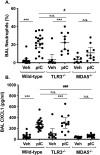
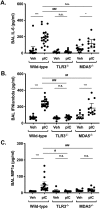
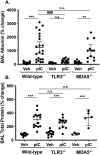
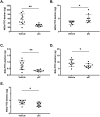
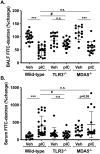
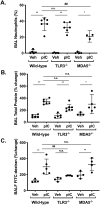
Similar articles
-
MDA5 and TLR3 initiate pro-inflammatory signaling pathways leading to rhinovirus-induced airways inflammation and hyperresponsiveness.PLoS Pathog. 2011 May;7(5):e1002070. doi: 10.1371/journal.ppat.1002070. Epub 2011 May 26. PLoS Pathog. 2011. PMID: 21637773 Free PMC article.
-
Double-stranded RNA exacerbates pulmonary allergic reaction through TLR3: implication of airway epithelium and dendritic cells.J Immunol. 2010 Jul 1;185(1):451-9. doi: 10.4049/jimmunol.0902833. Epub 2010 May 26. J Immunol. 2010. PMID: 20505141
-
Silica and double-stranded RNA synergistically induce bronchial epithelial apoptosis and airway inflammation.Am J Respir Cell Mol Biol. 2014 Sep;51(3):344-53. doi: 10.1165/rcmb.2013-0281OC. Am J Respir Cell Mol Biol. 2014. PMID: 24661197
-
Beyond dsRNA: Toll-like receptor 3 signalling in RNA-induced immune responses.Biochem J. 2014 Mar 1;458(2):195-201. doi: 10.1042/BJ20131492. Biochem J. 2014. PMID: 24524192 Review.
-
MDA5-filament, dynamics and disease.Curr Opin Virol. 2015 Jun;12:20-5. doi: 10.1016/j.coviro.2015.01.011. Epub 2015 Feb 9. Curr Opin Virol. 2015. PMID: 25676875 Free PMC article. Review.
Cited by
-
Inhibiting Protein Kinase D Promotes Airway Epithelial Barrier Integrity in Mouse Models of Influenza A Virus Infection.Front Immunol. 2020 Dec 14;11:580401. doi: 10.3389/fimmu.2020.580401. eCollection 2020. Front Immunol. 2020. PMID: 33381112 Free PMC article.
-
MDA5 signaling induces type 1 IFN- and IL-1-dependent lung vascular permeability which protects mice from opportunistic fungal infection.Front Immunol. 2022 Jul 28;13:931194. doi: 10.3389/fimmu.2022.931194. eCollection 2022. Front Immunol. 2022. PMID: 35967332 Free PMC article.
-
Developmental perfluorooctane sulfonic acid exposure exacerbates house dust mite induced allergic responses in adult mice.Sci Total Environ. 2024 Oct 10;946:173768. doi: 10.1016/j.scitotenv.2024.173768. Epub 2024 Jun 5. Sci Total Environ. 2024. PMID: 38844226
-
Budesonide promotes airway epithelial barrier integrity following double-stranded RNA challenge.PLoS One. 2021 Dec 6;16(12):e0260706. doi: 10.1371/journal.pone.0260706. eCollection 2021. PLoS One. 2021. PMID: 34871316 Free PMC article.
-
TLR3-Activated Monocyte-Derived Dendritic Cells Trigger Progression from Acute Viral Infection to Chronic Disease in the Lung.J Immunol. 2021 Mar 15;206(6):1297-1314. doi: 10.4049/jimmunol.2000965. Epub 2021 Jan 29. J Immunol. 2021. PMID: 33514511 Free PMC article.
References
-
- Reinert LS, Harder L, Holm CK, Iversen MB, Horan KA, Dagnaes-Hansen F, et al. TLR3 deficiency renders astrocytes permissive to herpes simplex virus infection and facilitates establishment of CNS infection in mice. J Clin Invest. 2012;122(4):1368–76. Epub 2012/03/20. 10.1172/JCI60893 - DOI - PMC - PubMed
Publication types
MeSH terms
Substances
Grants and funding
LinkOut - more resources
Full Text Sources
Molecular Biology Databases

